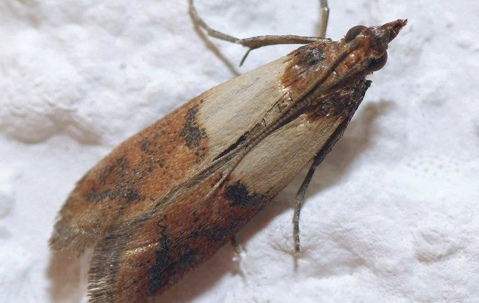Have you ever pulled out ingredients from your pantry to make something, only to realize that there are tiny here are little pests invading them? If so, you are most likely dealing with an infestation of stored product pests, also called “pantry pests”. There are several different varieties of these pests, some of the most common being the carpet beetle, cigarette beetle, confused flour beetle, Indian meal moth, and saw-toothed flour beetle. It is important to learn how these pests enter homes, what attracts them, and how to get rid of them in order to avoid an infestation.
Carpet beetles are very similar in shape to ladybugs when they are in the adult stage. The larvae are about ¼” long. They are bristly, dome-shaped pests that are brown to tan in color with light-colored stripes. They usually stay outdoors, feasting on pollen and plant nectar, but will sometimes come indoors through cracks and gaps. Sometimes, these beetles enter our homes in stored food from the grocery store as well. Once inside, they will find products like rice, flour, or cereal to lay their eggs in. Carpet beetles are not very dangerous to humans, but they can damage clothing, fabrics, and carpets. They can often be found in homes, museums, warehouses, and other businesses. These pests are attracted to the oils in fur and hair and are capable of crawling across people when they sleep to feed on hair. The bristles on carpet beetle larvae are known to cause a skin reaction in some people.
Cigarette beetles are oval- shaped and appear to be hunched over. They vary from brown, red, or yellow in color are about 1/10” at full size, which is very small. These beetles are very strong fliers, however. Cigarette beetle larvae are a white or yellow color with a dark brown head, and look very similar to grubs. These larvae are commonly found in and around stored products, as well as places with tobacco. They can also be found in dried spices, fruit, and flowers. They invade all kinds of environments including storage facilities, food stores, restaurants, and homes. While they are harmless to people, these beetles can still be a huge nuisance, contaminate food, and damage books and book bindings.
Confused flour beetles are reddish-brown and shiny, and can grow up to ⅛” long. They have wings that have ridged wing covers, but rarely fly. Their heads and upper thorax have tiny puncture marks which help distinguish them from other stored product pests. Their larvae are yellow or white in color and look like thin worms. These beetles can be found in food processing plants, grocery stores, and homes, usually inside refined products that are easy for them to eat such as flour and cereal. They are not a danger to humans either, but they do contaminate foods with their shed skins, eggs, and feces, which give off a bad odor and taste if consumed.
Indian meal moths can grow to be about ¾” long. Their wings are yellowish-gray in the front and dark gray, bronze, or copper in the back with a darker band between them. Their larvae are brown, white, and sometimes even tinted a green or pink color, with a yellowish-brown head and thorax. These moths will enter homes through cracks and gaps; however, these pests most commonly enter into your home through food bought at the grocery store that was infested with Indian meal moth larvae before you purchased it. Once inside your home, these moths lay their eggs inside food sources. They like a variety of foods including grains, seeds, nuts, candy, pet food, flour, dry milk, and spices. These pests do not sting, bite or cause any dangerous health problems. They will contaminate food inside your home and you will want to discard it right away so that the infestation can be limited.
Saw-toothed flour beetles are brown with narrow, flat bodies. They are very small, growing to only about ⅛” long. Their larvae look like tiny yellowish-white worms. These pests invade anywhere stored food is found, including homes, stores, and packaging businesses. They will mostly feed on grains, but are also known to eat dried meat, pasta, nuts, sugar, and tobacco. They are not known to cause any health problems, but they can contaminate food, and that food will need to be thrown out.
If you are dealing with an infestation of one or many of these pests, you will need to enlist the help of a pest control professional to eradicate them right away. Adams Exterminating Company in North Texas can help! Check out our year-round residential pest solutions and find one that suits your specific needs and budget for year-round pest control in North Texas - we’ll take care of the rest! Contact us today to learn more!

